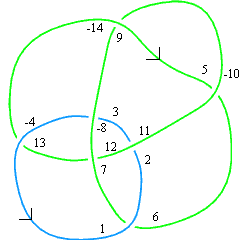DT (Dowker-Thistlethwaite) Codes
Links

DT Codes for links are defined in a similar way (see [DollHoste]). Follow the same numbering process as for knots, except when you finish traversing one component, jump straight to the next. It is not difficult to see that there is always a choice of starting points along the components for which the resulting pairing is a pairing between odd and even numbers. (On the figure above one possible choice is indicated). Again, it is enough to only list the even numbers corresponding to ; call the resulting list . (Above, ). Notice that the odd indices are naturally subdivided into sublists according to the component of the link on which they lie, and this induces a subdivision of into sublists. Thus with the choices made in the figure above, the DT code for the link L7n2 is .
KnotTheory` knows about DT codes for links:
In[7]:=
|
DTCode[Link[7, NonAlternating, 2]]
|
Out[7]=
|
DTCode[{6, -8}, {-10, 12, -14, 2, -4}]
|
In[8]:=
|
MultivariableAlexander[DTCode[{6, -8}, {-10, 12, -14, 2, -4}]][t]
|
Out[8]=
|
-1 + t[1] + t[2] - t[1] t[2]
|
[DollHoste] ^ H. Doll and J. Hoste, A tabulation of oriented links, Mathematics of Computation 57-196 (1991) 747-761.



